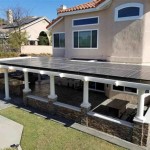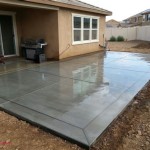Creating The Perfect Flagstone Patio Floor Plan
Designing and installing a flagstone patio involves careful planning to ensure a visually appealing, functional, and durable outdoor space. A well-executed floor plan is critical for a successful project, guiding the selection of materials, the installation process, and the overall aesthetic of the patio. This article outlines the key steps and considerations involved in creating the perfect flagstone patio floor plan.
The beauty of flagstone lies in its natural variations in color, shape, and size, offering a unique and organic look that complements various landscape styles. However, this inherent variability also presents challenges in planning and installation. A comprehensive floor plan addresses these challenges, minimizing waste, optimizing material usage, and ensuring a structurally sound and visually pleasing result. Ignoring proper planning can lead to a patio that is unstable, unattractive, and prone to premature deterioration.
1. Site Assessment and Measurement
The first step in creating a floor plan is a thorough assessment of the installation site. This involves evaluating the existing landscape, identifying any potential obstacles, and accurately measuring the area where the patio will be located. Begin by determining the desired size and shape of the patio. Consider its intended use, such as dining, lounging, or entertaining, and the amount of space required for furniture, pathways, and other elements. The patio's shape should complement the surrounding landscape and architectural style of the property. Avoid overly complex shapes that are difficult to construct and maintain.
Accurate measurements are crucial for estimating material quantities and minimizing waste. Use a measuring tape or laser distance measurer to determine the length, width, and any variations in the area's dimensions. Create a detailed sketch of the site, noting any existing features such as trees, shrubs, utility lines, or drainage structures. These features may influence the patio's design and layout. Also, consider the slope of the land. Flagstone patios typically require a slightly sloped base for proper drainage. The floor plan should account for this slope to ensure that water flows away from the house and does not pool on the patio surface.
Evaluate the soil conditions. A stable sub-base is essential for a long-lasting flagstone patio. If the soil is loose, sandy, or contains organic matter, it may need to be compacted or amended to provide a solid foundation. Consider conducting a soil test to determine its composition and drainage characteristics. Furthermore, assess the sun exposure and wind patterns in the area. This information can help in determining the placement of shade structures, windbreaks, or plantings to enhance the comfort and usability of the patio.
2. Defining the Layout and Pattern
Once the site assessment is complete, the next step is to define the layout and pattern of the flagstone. This involves selecting the type of flagstone, determining the spacing between stones, and creating a detailed drawing that shows the placement of each piece. Flagstone is available in a variety of colors, textures, and sizes. Choose a type that complements the surrounding landscape and architectural style. Common choices include bluestone, sandstone, and slate, each offering a unique aesthetic and level of durability. Consider the overall color scheme of your outdoor space, including the house, garden, and other hardscape elements, when selecting the flagstone color.
There are several patterns that can be used for a flagstone patio, including random, mosaic, and geometric. A random pattern is the most common and involves placing stones of varying sizes and shapes in an irregular arrangement. This pattern provides a natural and organic look that blends well with most landscapes. A mosaic pattern involves using smaller pieces of flagstone to create intricate designs or patterns. This pattern requires more skill and time to install but can result in a visually stunning patio. A geometric pattern involves using stones of uniform shapes and sizes to create a symmetrical design. This pattern provides a more formal and structured look that is suitable for contemporary landscapes.
Determine the spacing between the stones. The spacing affects the overall look of the patio and the amount of joint filler required. A wider joint typically requires more filler but allows for better drainage and accommodates slight variations in stone thickness. A narrower joint provides a more seamless look but may be more challenging to install and maintain. Consider the type of joint filler to be used. Common choices include polymeric sand, gravel, and mortar. Polymeric sand is a popular choice because it is easy to install, prevents weed growth, and provides a firm and stable joint. Gravel provides a natural and permeable joint that allows for good drainage. Mortar provides a more permanent and rigid joint that is suitable for high-traffic areas.
Create a detailed drawing of the patio layout, showing the placement of each stone. This drawing will serve as a guide during the installation process. Use graph paper or a computer-aided design (CAD) program to create the drawing. Indicate the dimensions of each stone, the spacing between the stones, and any other relevant details. Consider using different colored pencils or layers in the CAD program to distinguish between different types of stones or joint fillers. Before finalizing the layout, consider laying out the stones in the actual patio area to get a better sense of the overall look and feel. This allows for adjustments to the layout and pattern before the installation begins. Take photographs of the layout to serve as a reference during the installation process.
3. Drainage, Sub-Base, and Edge Restraints
Proper drainage is essential for the longevity of a flagstone patio. Water accumulation can lead to erosion, frost heave, and other damage. The floor plan should incorporate measures to ensure that water drains away from the patio surface. The patio should be sloped slightly away from the house or other structures to allow for runoff. A slope of 1/4 inch per foot is generally sufficient. Consider installing a drainage system, such as a French drain or a surface drain, to collect and redirect water away from the patio area. French drains consist of perforated pipes buried in a gravel-filled trench. Surface drains consist of grates that collect water and channel it into a pipe. The type of drainage system will depend on the site conditions and the amount of water to be managed.
A stable sub-base is critical for preventing settling and shifting of the flagstone. The sub-base should consist of a compacted layer of gravel or crushed stone. The thickness of the sub-base will depend on the soil conditions and the expected traffic load. A sub-base of 4 to 6 inches is generally sufficient for residential patios. The sub-base should be compacted using a plate compactor to ensure that it is firm and stable. A layer of landscape fabric should be placed between the sub-base and the bedding layer to prevent weeds from growing through the patio. The bedding layer should consist of a thin layer of sand or stone dust. The bedding layer provides a smooth and level surface for the flagstone to rest on.
Edge restraints are necessary to prevent the flagstone from shifting and spreading over time. Edge restraints can be made from various materials, including concrete, brick, stone, or plastic. The type of edge restraint will depend on the style of the patio and the surrounding landscape. Concrete or brick are durable and provide a clean and finished look. Stone provides a natural and rustic look that blends well with flagstone. Plastic edge restraints are lightweight and easy to install. The edge restraints should be installed securely and level with the patio surface. Consider using a concrete footing or a gravel base to provide additional support for the edge restraints. Proper installation of edge restraints ensures the structural integrity and visual appeal of the patio.
In summary, creating the perfect flagstone patio floor plan requires careful consideration of site conditions, layout, drainage, and sub-base construction. A well-executed plan will ensure a durable, functional, and aesthetically pleasing outdoor space that enhances the value and enjoyment of the property. Careful attention to these details will result in a flagstone patio that will last for many years.

How To Build A Flagstone Patio In One Day Merrypad

How To Build A Flagstone Patio In One Day Merrypad

How To Install A Flagstone Patio Step By

Flagstone Patio Ideas Cost How To Install Landscaping Network

How To Build A Flagstone Patio Greenacresodfarm Com

How To Build A Paver Patio Young House Love

How To Install A Flagstone Patio Handyman Startup
:strip_icc()/101427270-f2fbe431e7174e86945a62e011e4d361.jpg?strip=all)
How To Install A Flagstone Patio Our Step By Guide

Backyard Quartzite Flagstone Patio 14 Steps With Pictures Instructables

Flagstone Patio Ideas Cost How To Install Landscaping Network
Related Posts








